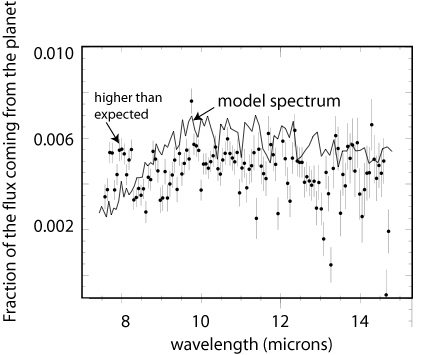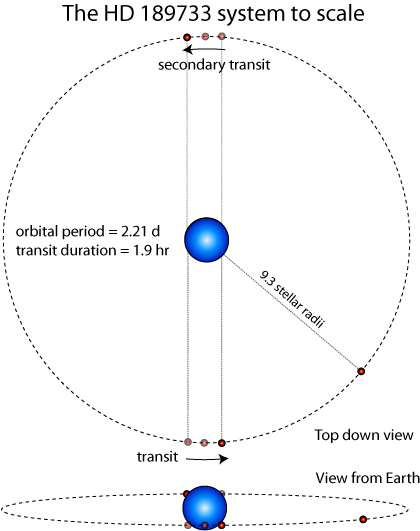
Image Source.
So, uhh, yeah, the oklo blog went through a dry spell with no posts last week. This was primarily a consequence of the fact that Spitzer GO-4 proposals were due last Friday. I teamed up with Drake Deming of GSFC and UCSC physics grad student Jonathan Langton to propose a 30-hour observation of HD 80606b during the ‘606 day that’ll occur next November 20th. In an upcoming article, I’ll be pushing the reasons why we’re really excited about the possibility of observing HD 80606 b during its big periastron swing.
The Spitzer Space Telescope has turned out to be a regular wellspring of exo-planet results. It’s providing very interesting and often surprising constraints on the weather conditions at the surfaces of the hot Jupiters, and another big new result was announced today. Three different teams released the first-ever observations of emergent infrared spectra from two observational runs on HD 189733 and HD 209458.
The transiting planet HD 189733 b was discovered by the Swiss team in 2005. Of the fourteen known transiting planets, HD 189733 b is the best-suited for detailed follow-up observations. The parent star lies only 19 parsecs away, the orbital period is a skimpy 2.1 days, and the 1.15 Jupiter-mass planet has a radius fully 15% the size of the primary star’s radius. Like the other transiting systems, the planet, the orbit, and the star can all be drawn completely to scale on a “saved for web” diagram that’s only 420 pixels across:
Grillmair et al.’s Spitzer spectrum of HD 189733 was obtained with 12 hours of observation, in which the brightness of the star at infrared wavelengths between 7 and 14 microns is compared in and out of the secondary transit:

The observed flux distribution from the planet is nearly completely flat as a function of wavelength! Models of the atmospheres of hot Jupiters had all predicted that the presence of water vapor in the planetary atmosphere would lead to a prominent absorption feature at ~8 microns. No hint of the predicted dip was seen. The overall amount of infrared light coming from the planet during the secondary transit indicates that heat is probably being efficiently redistributed between the day and night sides of the planet.
A Nature paper by Jeremy Richardson and collaborators reported a very similar result for HD 209458 b. Their spectrum runs between 7.5 and 13.2 microns, is similarly devoid of absorption features, and also suggests a modest day-night temperature difference.
So how to interpret these results? One possibility is that the lack of absorption lines is caused by a high, uniformly emitting cloud layer, perhaps made of silicate grains. A problem with this interpretation, however, is that the cloud decks would have to be extremely dark and unreflective in the optical. Hot Jupiters absorb nearly 95% of the radiation that they receive from their parent stars. Another possibility, put forward by Jonathan Fortney, is that the atmospheres of these planets are isothermal down to large optical depths. Because we can’t actually see to a hotter underlying layer, there’s no mechanism for deep absorption lines to form.
And finally, another, rather startling, interpretation of the results was offered several hours ago by CBS News:

Image Source.


Pingback: systemic - Running hot and cold